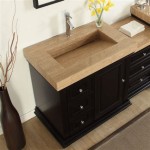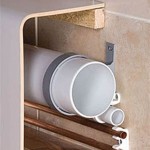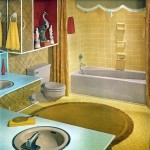Mini Bathroom Sinks: Maximizing Space in Compact Areas
The modern home often presents space-related challenges, particularly in bathrooms. Many apartments, condominiums, and even older houses feature smaller bathrooms where traditional-sized fixtures overwhelm the available area. In these situations, the selection of appropriately sized bathroom elements becomes critical. Mini bathroom sinks provide a viable solution for maximizing usability without sacrificing functionality or aesthetics.
Mini bathroom sinks, characterized by their reduced dimensions, offer numerous advantages for small bathrooms. They are designed to fit into tight corners, narrow spaces, and powder rooms where a standard sink would be impractical. This allows for a more comfortable and efficient use of the available floor space, improving overall bathroom flow and usability. The market offers a comprehensive array of styles, materials, and mounting options, ensuring that a suitable mini sink can be found for virtually any bathroom design scheme. This article will explore the key benefits, types, and considerations involved in selecting a mini bathroom sink for a compact bathroom.
Optimizing Space and Functionality
The primary advantage of mini bathroom sinks lies in their ability to optimize space. In small bathrooms, every inch matters. A standard-sized sink can easily dominate the room, leaving little room for maneuvering or other essential fixtures. Mini sinks, on the other hand, are specifically designed to minimize their footprint. They achieve this through reduced width, depth, or both. This reduction in size allows for more open floor space, making the bathroom feel less cramped and more comfortable to use.
The space saved by using a mini sink can be re-allocated to other important bathroom features. For example, it might allow for the installation of a small storage cabinet, a larger shower, or simply more comfortable movement within the room. In a powder room, where the primary function is handwashing, a mini sink is often sufficient, freeing up space for decorative elements or improved accessibility.
Despite their smaller size, mini sinks do not necessarily compromise on functionality. Many designs incorporate features to maximize their utility, such as deep basins or integrated storage solutions. The effectiveness of a mini sink in a small bathroom hinges on careful planning and consideration of individual needs and usage patterns. For instance, a frequently used bathroom might require a mini sink with a deeper basin to minimize splashing, while a powder room might prioritize aesthetics and a smaller profile.
Exploring Different Types and Mounting Options
The variety of mini bathroom sinks available is extensive, encompassing a range of styles, materials, and mounting options. This diversity allows homeowners to select a sink that not only fits their space constraints but also complements their overall bathroom design. Understanding the different types of mini sinks and their respective advantages and disadvantages is crucial for making an informed decision.
Wall-mounted sinks: These sinks are attached directly to the wall, freeing up floor space underneath. This can create a more open and airy feel in a small bathroom, making it appear larger than it actually is. Wall-mounted sinks are often paired with a pedestal or exposed plumbing, which can add a touch of visual interest. However, it's essential to ensure that the wall is structurally sound enough to support the weight of the sink and its contents.
Corner sinks: Designed to fit snugly into a corner, these sinks are ideal for maximizing space in awkwardly shaped bathrooms. They utilize space that would otherwise be unusable, creating a more efficient layout. Corner sinks are particularly well-suited for powder rooms or bathrooms with limited wall space.
Pedestal sinks: These sinks consist of a basin supported by a single pedestal base. While they do take up some floor space, their slim profile makes them a good option for small bathrooms. Pedestal sinks offer a classic and elegant look, but they typically lack built-in storage.
Vessel sinks: These sinks sit on top of a countertop or vanity, rather than being installed within it. Vessel sinks can add a touch of modern style to a bathroom. Mini vessel sinks are available in a variety of shapes and materials, offering a wide range of design options. However, it's important to select a low-profile vessel sink to avoid overwhelming the space.
Vanity sinks: Integrating a mini sink into a small vanity unit provides valuable storage space underneath. This is particularly useful in small bathrooms where storage is at a premium. Vanity sinks are available in a variety of styles, from traditional to modern, and can be customized to fit specific needs. A small vanity provides enclosed space for toiletries, cleaning supplies, and other bathroom essentials, contributing to a more organized and clutter-free environment.
The choice of mounting option should be guided by both space constraints and aesthetic preferences. Wall-mounted sinks are excellent for creating a sense of openness, while vanity sinks offer practical storage solutions. Corner sinks are ideal for maximizing space in awkward corners, and vessel sinks can add a touch of modern flair. Careful consideration of these factors will ensure that the selected mini sink complements the overall bathroom design and meets the specific needs of the user.
Material Selection and Design Considerations
The material of a mini bathroom sink not only impacts its durability and maintenance requirements but also contributes to its overall aesthetic appeal. Common materials include porcelain, ceramic, glass, stainless steel, and stone, each offering distinct properties and visual characteristics. Selecting the right material is crucial for achieving the desired look and ensuring long-term satisfaction.
Porcelain and Ceramic: These are the most common materials for bathroom sinks, known for their durability, affordability, and ease of cleaning. Porcelain and ceramic sinks are resistant to scratches, stains, and chemicals, making them a practical choice for everyday use. They are available in a wide range of colors and styles, providing versatility for various bathroom designs. Glossy finishes are typical, contributing to a clean and hygienic appearance.
Glass: Glass sinks offer a modern and elegant look. They are typically made of tempered glass, which is strong and resistant to shattering. Glass sinks are available in a variety of colors and textures, allowing for unique and eye-catching designs. However, they can be more prone to water spots and fingerprints and may require more frequent cleaning.
Stainless Steel: Stainless steel sinks provide a sleek and contemporary aesthetic. They are highly durable, resistant to rust and corrosion, and easy to clean. Stainless steel is a practical choice for modern bathrooms and offers a clean, minimalist look. However, stainless steel sinks can be prone to scratching and may show water spots.
Stone: Stone sinks, such as granite or marble, offer a luxurious and natural look. They are durable and add a touch of elegance to any bathroom. Stone sinks are available in a variety of colors and patterns, making each sink unique. However, stone sinks can be more expensive and may require special care to prevent staining.
In addition to material selection, several design considerations should be taken into account when choosing a mini bathroom sink. The shape of the sink, the depth of the basin, and the style of the faucet can all impact the functionality and aesthetics of the sink. A deeper basin can help to minimize splashing, while a narrower sink can save space in a tight bathroom. The style of the faucet should complement the sink and the overall bathroom design. A wall-mounted faucet can create a more streamlined look and save space on the countertop.
Lighting plays a significant role in enhancing the visual appeal and functionality of a mini bathroom sink. Adequate lighting around the sink area is essential for tasks such as washing hands, shaving, and applying makeup. Consider installing a mirror with integrated lighting or adding sconces on either side of the mirror to provide ample illumination. Proper lighting can also make a small bathroom feel more spacious and inviting.
Finally, the overall design scheme of the bathroom should be considered when selecting a mini bathroom sink. The sink should complement the other fixtures and finishes in the room, creating a cohesive and harmonious look. Consider the color palette, the style of the tiles, and the overall aesthetic of the bathroom when choosing a mini sink that will enhance the space.
By carefully considering these factors, homeowners can select a mini bathroom sink that maximizes space, enhances functionality, and complements their overall bathroom design.

8 Small Bathroom Sinks That Will Make A Big Impact Architectural Digest
:max_bytes(150000):strip_icc()/fin-10-teensy-luxe-bathroom-5a2dbb72da27150036dcdf91.jpg?strip=all)
7 Tiny Bathrooms B With Stylish Function

14 Genius Small Bathroom Design Ideas

14 Splendid Small Bathroom Sink Ideas Shelfgenie

14 Splendid Small Bathroom Sink Ideas Shelfgenie

Decoration724 Com Small Bathroom Sinks Styles Toilet

21 Simple Small Bathroom Ideas Victorian Plumbing

14 Splendid Small Bathroom Sink Ideas Shelfgenie

15 Small Bathroom Vanity Ideas That Rock Style And Storage

Cosa Mini 48r 86103r By Ws Bath Collections Small Ceramic Wall Mounted Bathroom Sink 18 9 Left Faucet Hole Modo







